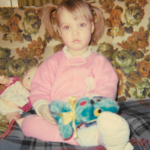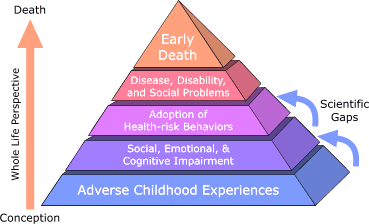 My Neurofeedback Journey, 1 of 2
My Neurofeedback Journey, 1 of 2
by Tina Marie Hahn
— as told to Kathy Brous
I am Dr. Tina Marie Hahn, MD, advocate for Trauma-Informed Care and Communities, and survivor of actually ten Adverse Childhood Experiences (ACEs). As a pediatrician, I screen parents and children alike for childhood trauma. That’s me at 30 months old and my background story is here: http://acestoohigh.com/2014/05…-her-ace-score-is-9/
I’ve been excited for some time to try neurofeedback, after listening to a talk given by Dr. Bessel van der Kolk and Sebern Fisher and reading Dr. van der Kolk’s latest book “The Body Keeps the Score” and a blog on Sebern Fisher’s work with neurofeedback here at http://attachmentdisorderhealing.com/neurofeedback/ I then read three books on neurofeedback, including Dr. Fisher’s book “Neurofeedback in the Treatment of Developmental Trauma: Calming the Fear-Driven Brain” and decided to research several electronic neurofeedback systems for home use.
I report as a user/patient, not as a doctor or expert, because my experience so far has been fairly stormy — I’m just starting out, so I don’t know where this will go and I am not an expert. I feel I should warn readers: if you have experienced severe infant and childhood developmental trauma as I did, neurofeedback seems like a very rewarding method for healing — but it has intense risks if not done with care.
Please if possible, as Kathy’s book says: “Don’t Try This at Home.” Neurofeedback is designed to be done in a trained practitioner’s office. So for most people with trauma, probably it’s best not to do neurofeedback alone at home. Please try to do it with access to formal support, hopefully a good attachment-based psychotherapist who is very compassionate, so you can discuss what is happening and process these deeply brain stem based emotions with another human. If therapy is really impossible, maybe you could create a group of healing friends or at least have a friend come regularly to be with you while you do it or afterward. Some type of support would be key.
I had to opt for a home-use neurofeedback system because I am in a rural backwater where everyone knows everyone so I don’t feel comfortable sharing incredibly strong emotions. I’ve also had prior bad experiences with psychiatry plus right now there aren’t good practitioners anywhere near where I live. In fact, I might be doing better if I had a well-trained therapist possessing extensive knowledge of developmental trauma.
As to the level of pain in my healing with neurofeedback so far: I have been working on this level of emotional pain for decades, so (thus far) it seems I have an ability to tolerate this intense experience. (I won’t know how much I can tolerate until I go further, who knows.) But I did want to note that unless a person is willing to take chances and is pretty strong, they might get really shaken up.
The Fear-Driven Amygdala
I wanted to specifically treat my fear-driven amygdala that I have from being terrorized as an infant and child. I found one home system, which looked good, but it did not allow one to use different protocols to specifically calm down an overactive amygdala.
So I chose BrainPaint®, which did, and I was excited to get my BrainPaint® home neurofeedback system in the mail April 6. BrainPaint® sent an excellent 47 minute video tutorial showing me how to set up the system and before the first session, I had an 1.5-hour phone tutorial. The system is very easy to set up and use. Also we get 45 minutes of assistance by phone every month we rent the system, and we can pay extra for more telephone help if we need it. I will be texting or calling my BrainPaint® “assistant” to help me as I become ready to change protocols based on symptom improvement.
BrainPaint® is not cheap but mental health and well-being? Priceless. The BrainPaint® set I got has a minimum two months rental at $675 per month for shipping and a deposit; I initially paid $1,875. The deposit comes back when you send the rental back. Here is an introductory YouTube video: https://www.youtube.com/watch?v=7s0AFjRVfmk
I did my first session April 7; it starts with a symptom checklist. I had lots of symptoms checked. The protocol chosen initially was to calm my right amygdala— but because it looked like so many areas were out of whack, I did something called “non-linear on T3 and T4″ (right and left temporal) to get the brain hemispheres in synch.
My first session was 7 minutes….. It was interesting.. Looking at a screen with fractal patterns and auditory inputs. After the first 7 minutes, I fell asleep for 2 hours. For me that is amazing because I don’t take naps and don’t sleep well… I feel relatively calm and just completed a second session for 14 minutes. I am now pretty tired.
I don’t know the outcome of this process, but I have a strong feeling that neurofeedback is going to help rid me of my low self esteem, my rough edges and though I am really tired, I think this is going to really make some good changes. It already did something, as normally looking at a computer screen would never make me take a nap.
More Good Results
On April 8, I had more good results: I did a few more BrainPaint® sessions throughout the day. Then last night I slept the best I have in months!
On April 20, I did an “Alpha-Theta” session on BrainPaint® and had a rather weird experience so here’s what happened:
I am stuck inside an ostrich shell. I am really stuck. I am little but grown. I am pushing on the shell. It doesn’t move and all around me is space …. lots of space.. me in a shell… then I flash into the basement…. it is dark but there is a window a small window that is in the basement and I look outside trying to see the outside where it is light and bright and trees and leaves and I am stuck…
I don’t fight, I just flash back into the eggshell… then I think I cannot push this open… I will try to melt it away into infinity ..the infinity of equanimity ….. then it was done….
I suppose this is what we experience in the early sessions.
Coming July 24: Part 2 of Tina’s amazing report
———————————
Kathy’s blogs and Guest Blogs explore the journey of recovery from childhood trauma by learning about Adult Attachment Disorder in teens and adults, Adult Attachment Theory, and the Adverse Childhood Experiences (ACE) Study.
4,301 total views, 1 views today



Just found this- how are you doing? Going to read your other posts